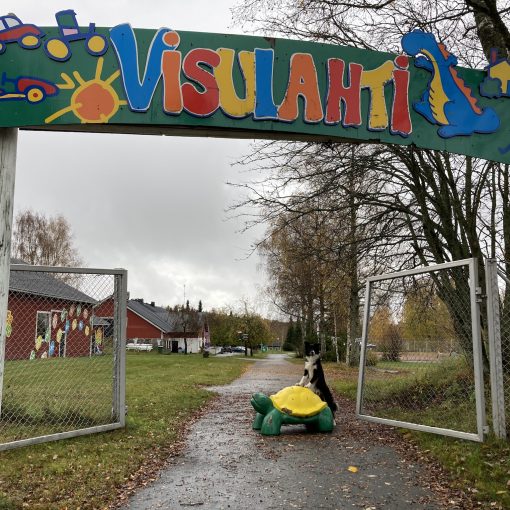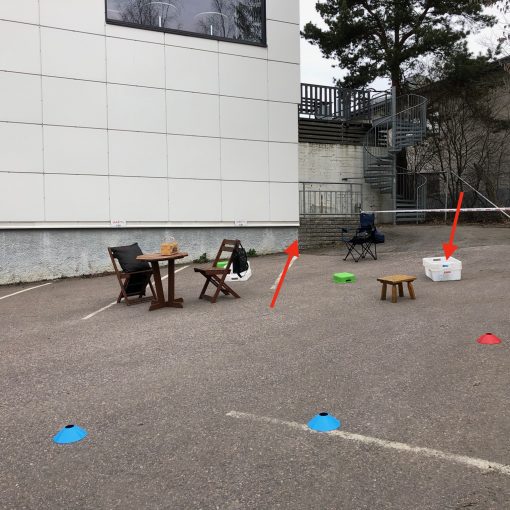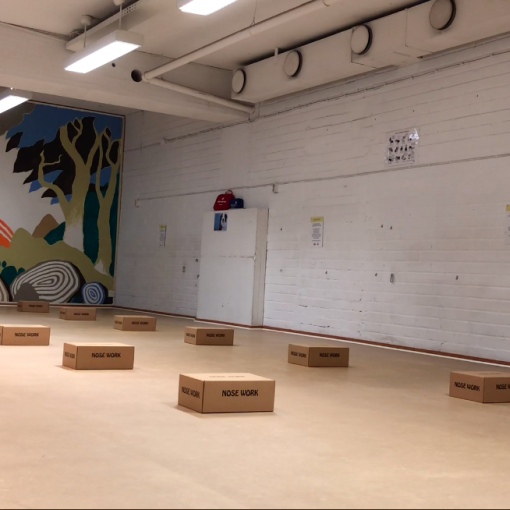What are the skills that the dog and the handler should have as a team to be able to participate successfully in the trials in nose work two level? How do those trials differ from the level one trials? Following are some main points I have noticed while trialing here in Finland where this canine sport is relatively young meaning that the very first NW2 level trial was held in late 2018. So far there have not been any NW3 level trials yet in Finland.
Search area size and number of hides
All elements trials contain interior building search, exterior area search, vehicle search, and container search. In the nose work level one trials there is one target odor to be found and there will not be any distractors. Naturally, there can be natural distractors in the search areas. Maximum search times will vary, but they are quite moderate varying between one to five minutes. In practice, those maximum times have been between 1.5–3 minutes.
In level two, trials search area sizes are mainly bigger. For example, in the interior building search, there may be two rooms to search, and in the container search there may be a lot more boxes (in the level one 12-25 boxes, in the level two 20-50 boxes), and in the vehicle search there may be up to four vehicles to be searched. Also, there are two target odors, including the combination of those two. Each search area may contain two hides. It is also possible that there are some distractors. For example, in the container search, there can be clothes, fur, sand and other distractions inside the containers. Some substitutes are not allowed in the search area, and for example, in Finland, those are tea, coffee, Kong, mushrooms, tennis balls, any products containing the target odors and other strong chemicals.
Even if the search area size gets bigger and the number of hides increases, the maximum search time may not change compared to the level one trials. In practice, those maximum search times seem to be between 1.5–3 minutes as well.
Because of the search area size, number of hides and finding hides in the given maximum time, important skills are fast focusing on the search right from the beginning, clear indication (or handler must be able to quickly call the “alert”), continuing search from the first find and going through the search area practically.
Start of the search
It is really important that your dog focuses on the search right away. Certain routines that suit for the dog will help. It is good to know, how you can prepare your dog to the upcoming search and all those things that are going to happen before that. For example, depending on the circumstances there may be long waitings. In some trials, you can go almost straight from the car to the search area but in some trials, you have to wait for your turn in defined waiting spots. That means that if there are, for instance, total four waiting spots and one dog is doing two searches in a row, the waiting time may be up to 15–30 minutes depending on how quickly the previous dogs perform their tasks.
Each dog team has their own routines and reward methods, and some teams will use the maximum time anyway. And if the hide is not found, each team has a possibility to do the find, when the judge first shows the dog handler where the unfound hide is. And of course, after each search, the dog handler will get the feedback from the judge.
It is good to think about these things beforehand and also train how these possibly long waiting times affect your dog and yourself. How can you ensure that your dog’s state of mind is optimal when you are heading to the search area? If dog’s arousal state goes up too much because of the waiting, this can easily cause some unwanted behaviors appearing, for example, scratching the boxes, licking the hides or something else that affect the search area. And as a competitor point of view, this means faults.
Also, it is good to know what to do if your dog’s arousal state goes below the optimal? Can you, for example, use some carpet where your dog can have a break? Or is it better to do some tricks or let your dog search “blank areas” before you go to the search area?
In any case, it is important that the dog focuses on the search right away when passing the start line. There is no time for unnecessary explicitly in the level two trials, especially if there are some challenging hides.
Video (English subtitles available and can be turned on from YouTube “Closed Captioning” “CC” icon):
Indication
Even if there are no specific demands about how the dog indicates, the dog handler must be able to show the direction of the target odor if the judge asks that. This may happen in those cases where the hide is so high that the dog cannot reach it. In level two max height is 1.6 meters. The hide can also be in an unreachable place which means that dog cannot reach the hide even if it is a low one. The dog is not allowed to touch the hide or affect the search area in any other way such as scratching, licking, rolling or peeing. These behaviors mean fault points, and when the size of the search areas and the number of hides increase, also possibility to get more fault points increases, if the dog inclines to any of these behaviors.
To get a qualifying result you need a trial result of 100 points with no more than three faults. Many very talented and fast dogs may be left without a qualifying result if it handles the things recklessly in the search area. And if you just think about the area specific result, the result with a slower time but no faults is higher on the scoreboard compared to the result with the fastest time but with one fault.
This comes to the indication. In case you are going to advance into the level three, you need to pay attention to how your dog indicates the hide. It is wise to teach the indication properly right from the beginning. The time you use in the foundation training will certainly pay you back in higher classes. This is one thing I would think twice when training a new nose work dog. I would be very certain how I want my dog to behave when he has found the hide. It is so much easier and faster to make changes to your training compared to that situation where the dog has repeated the unwanted behavior for years.
Video (English subtitles available and can be turned on from YouTube “Closed Captioning” “CC” icon):
Searching the area
The role of the dog handler grows in the level two trials compared to the level one where it may not be necessary to handle your dog. In level two you need to be ready for this. What are you going to do if your dog is working really hard but is not able to locate the odor? Are all the search area corners really checked? How about windows, radiators, air conditioning, possible obstacles, wind, and other conditions? Is there something that you can do to fasten up your dog’s performance?
It is wise to think about these things when you are walking through the search areas before the trials. Of course, the conditions vary especially outside and the search circumstances may be totally different from the first and the last dog. It is also good to decide what equipment should be used, for example, is the long leash more practical (dog handler has to know how to use the long leash properly) than a shorter leash? For example, in the interior building search, a shorter leash may be a better choice if it is not allowed to search off the lead and the area contains lots of objects that dog can easily go under. Instead, in the container search, a long leash may be a good choice in those circumstances where the dog handler can just stay at the start line.
It is also good to know your dog’s search preferences and how he checks the area. Does he search first high hides or does he prefer to search low hides? Does he climb easily? Does he check certain objects first? Does he check the corners? Are there some places that dog may leave unchecked?
Video (English subtitles available and can be turned on from YouTube “Closed Captioning” “CC” icon):
Continuing the search after the first find
Since there may be up to two hides in the level two trials per search area it is important that dog is able to continue the search at once the first hide is found. The judge tells the number of the hides which means that the dog handler can plan the tactics that suit for the dog. In the level three trials, there is an unknown number of hides, so the dog handler needs to tell when all the hides are found and the search is finished.
It is good that the dog is able to continue after the first find and does not go back and indicate the same hide again. Of course, the dog handler has to reward the dog carefully, since if a toy or a treat drops it means a fault. Also rewarding needs to happen at least one meter away from the hide. Secondly, you need to reward quickly so that you can continue the search at once. After the second find, there is a lot of time to reward your dog outside the search area.
Continuing the search is one thing that you can train so that it will become a routine. One way to do it is to reward with a small treat at the first find and then move on. And when the second hide is found, then the dog gets the super reward.
Video (English subtitles available and can be turned on from YouTube “Closed Captioning” “CC” icon):
Ready for the trials?
If you feel that previous points are in order, go ahead and register to the level two trials. Anyway, you will learn new things there, and you will get some perspective on how good you and your dog are as a team in relation to the other teams. And remember, to your dog, trial searches are (or should be) as fun as your normal training sessions! So reward your dog joyfully whatever outcome you get!
This article was first published in Finnish on SporttiRakki site: https://sporttirakki.fi/2019/04/26/blogi-koirakkona-noseworkin-kakkosluokan-kokeessa/
About the author:
Päivi Kokko has participated in NW2 level trials four times with her 6-year-old Finnish Lapphund Kero having results of two score of 100 points. They have been training nose work since late 2016.




